On 11 September 2001, Arlene and I boarded a plane for San Francisco at London’s Heathrow airport. The attacks on the World Trade Center happened about an hour into our flight. Here is what happened to us over the next several days, as published in the Nov-Dec 2001 issue of the Reel & Strathspeyper, the newsletter of the San Francisco branch of the Royal Scottish Country Dance Society.
Travel
Croatia 5: Klapa

We arrived in Split two days before St Duje’s Day, and discovered to our delight that one of the festivities was a klapa concert. It was to be held in the peristil, the central collonaded area in Diocletian’s Palace. No fewer than sixteen different klapa groups participated, almost half of them women’s groups (until very recently, klapa groups were exclusively male). This was very definitely a concert by and for Croatians: the audience was mostly friends and relatives of the various groups.
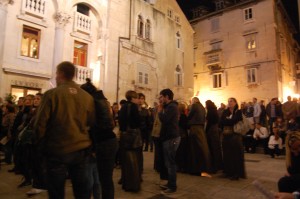
It was also a lesson in local customs. The audience was supportive, but also talked freely during the music, and didn’t care about blocking the views of those sitting down on the side stairs (even ignoring other locals who were complaining to the standees in Croatian). Smoking? No problem: almost everyone smokes cigarettes in Dalmatia. We even saw pregnant women smoking.
Klapa is wonderful music, but it’s nothing like the Croatian music I’m most familiar with. Why is this? A glance at a map of Europe reveals dozens of small countries, but most of them are composed of even smaller regions with distinctive languages and traditions. Over my folkdance career I’ve learned many Croatian dances, but it turns out that almost all of them are from Slavonia, the northern inland area of Croatia bordering Austria and Hungary. Our vacation was in Dalmatia, along the south-eastern shore of the Adriatic Sea: just 150 miles from Slavonia as the crow flies, but a very different place. We think of Croatia as an Eastern European country, but Dalmatia has a very western feel, much like Italy. This is not surprising given that the Republic of Venice controlled and influenced Dalmatia from the middle Ages until the Napoleonic Wars. Italy also occupied several pieces of Dalmatia between the two World Wars. All of which explains why klapa sounds so pleasingly western to my ears. If the words were in Italian instead of Croatian, I would never guess that the music wasn’t Italian.
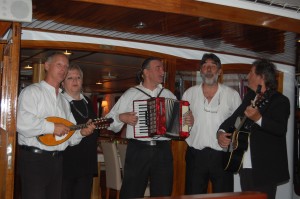
We were treated to a second, more intimate klapa concert while in KorÄula. Klapa Dalmacija, a group from the town of Vela Luka on the other side of the island, serenaded us during dinner. Later on, while they were having their own dinner, they kept singing. We bought one of their CDs and play it often as a reminder of our trip.
Croatia 4: The Walls of Dubrovnik
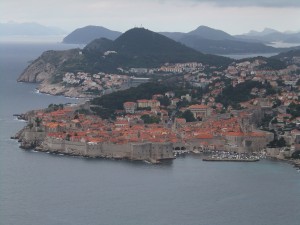
In 1929 George Bernard Shaw said “If you want to visit heaven on earth, come to Dubrovnik.” Hundreds of thousands of tourists take him up on it every year. We were there in May, before the summer hordes arrived, but it was still crowded during the morning hours when the big cruise ships were in port. Dubrovnik is very picturesque: you will be taking photographs around every corner.
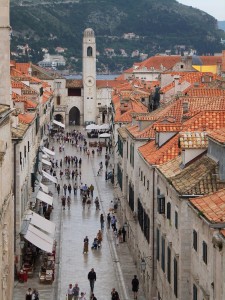
Dubrovnik boasts a magnificent wall completely surrounding the Old City, and for a modest charge you can walk the whole way around on top. I spent two hours making the circuit, wearing out my camera battery in the process. The walls have everything a castle-loving American could want: spectacular views, huge guard towers, 17th-century ruins, sheer cliffs above the crashing waves, and the chaotic geometry of hundreds of terracotta tile roofs.
Most of Dubrovnik was destroyed in the earthquake of 1667. It was rebuilt quickly, and so many of the buildings share the same architectural style, most notably along the wide main street, called Stradun (“big street”). Dubrovnik was shelled in the 1991 war that followed the breakup of Yugoslavia, an act that prompted widespread outrage. Almost all of the 1991 damage has been repaired, but I kept forcing myself to remember that this was only twenty years ago: all the adults here lived through that.
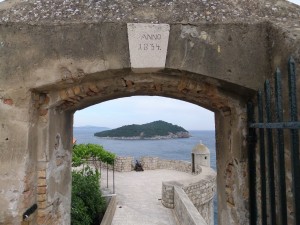
For all its apparent livlihood, the most recent census counted only 1000 Croatian residents inside the Old City. Many locals fear it will become a ghost town, catering only to tourists—a sentiment familiar to the residents of Venice, 300 miles up the Adriatic coast from here.
Read David’s other blog posts about the Croatia trip!
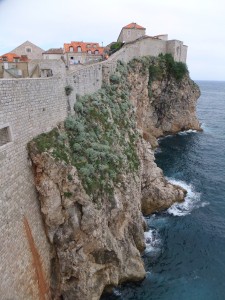
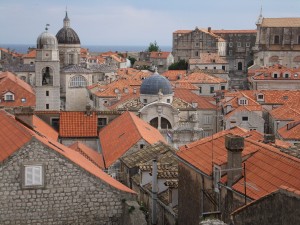
Croatia 3: Where have you gone, Marko Polo?
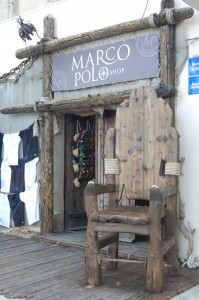
The Venetians hail famous explorer Marco Polo (1254?-1324) as one of their own, but Croatians will tell you that Marko—with a ‘k’—was actually born in the town of KorÄula, on the island of the same name. For someone who died almost 700 years ago, he is in excellent health: Marko Polo house, Marko Polo restaurant, Marko Polo ice cream… the man is around every corner.
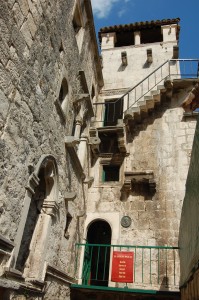
Don’t let this deter you from visiting KorÄula, however. It is a compact, circular walled town on the eastern tip of the island, overlooking the strait of PeljeÅ¡ac. It has charm and views in abundance. The distinctive herringbone pattern of streets was supposedly designed to permit airflow but to protect against high winds.
At the center of the walled town, at the top of the hill, is the cathedral of St Mark. The exterior is decorated with many carved faces: humans, mermaids, animals. The interior has a beautiful wooden roof which contrasts with the light grey stone. If St Mark rings a bell, it is indeed the same saint as San Marco in Venice—which makes sense when you remember that Venice controlled modern-day Dalmatia for several centuries. There are many buildings in KorÄula decorated with the winged lion of Venice.
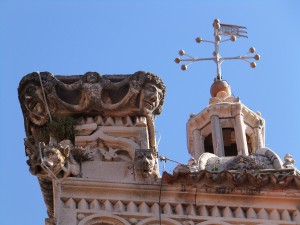
I can also speak highly of KorÄula’s pastries. The ice cream, not so much. Nothing we had anywhere in Croatia comes close to the quality of Italian gelato.
Read David’s other blog posts about the Croatia trip!

![]()
Croatia 2: Be careful in that belfry
I’ve always liked climbing up to the top of tall buildings in Europe. It’s probably because I like stone circular staircases so much. St Paul’s in London, Notre Dame in Paris, St Peter’s in Rome, the Duomo in Florence. Typically I enter a doorway off to one side of the cavernous central space, and ascend the various claustrophobic staircases until I emerge at the top and take in the breathtaking view of the ancient city. The large domes are particularly interesting because the final ascents are sandwiched in between the inner and outer shells of the dome.
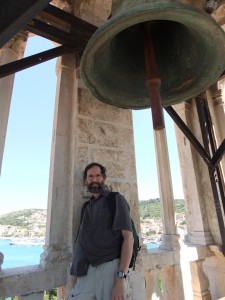
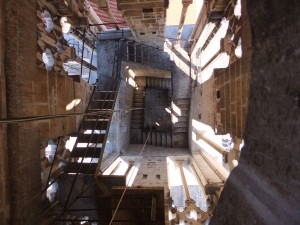
So when we arrived in Croatia, naturally I wanted to ascend the first belfry tower I encountered: Saint Duje’s Church, inside the Roman-era “Diocletian’s Palace” in Split. I paid my 10 kuna (about $2) and I headed up the staircase. Halfway up, however, I realized what I had gotten myself into: instead of a safe, windowless stone staircase, I was on metal stairs attached to the sides of the tower on one side. The other side was a sheer drop to the bottom of the shaft. It may seem contradictory that I both enjoy climbing towers and have a pronounced fear of heights, but there you are. It took every ounce of “when am I coming back to Croatia? Carpe diem!” that I could muster to steadfastly ignore the chasm beside me and concentrate only on climbing the stairs.
So two days later, in the delightful walled town of Trogir, what I did do? Why, I climbed another bell tower, this one with an even rustier and more rickety staircase than the first. My friend and fellow musician Mary Lea was a big help getting me to the top. The last few steps were as steep as a ladder, and involved stuffing myself through a hole about two feet square.
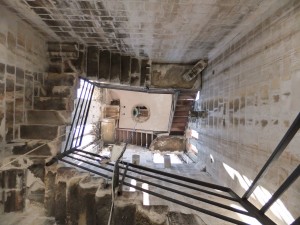
Two belfries were enough for me! Later in the trip, however, I did take a walk along the magnificent city walls in Dubrovnik, which were stunning and not at all acrophobic.